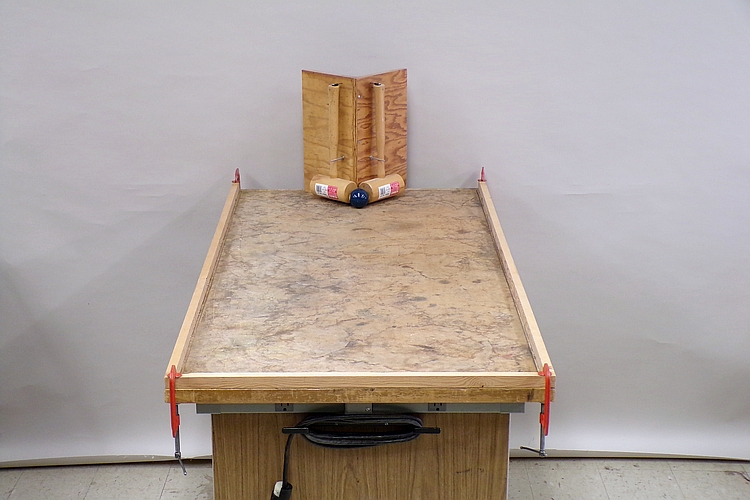
Two mallets are attached to two boards that are perpendicular to each other, via a pivot at the end of the handle. When you raise either mallet and then release it, it swings downward to strike the billiard ball placed between them. By raising both mallets to various heights, you can change the force with which they strike the billiard ball. You can also raise them to different heights, so that they strike the billiard ball with unequal force. In these ways you can vary the speed of the billiard ball and the direction in which it rolls when it is struck by the mallets.
Demonstrations 12.03 -- Spring scales on protractor board, and 12.06 -- Components of force, illustrate the vector addition of forces in static systems. In the first demonstration, a 1-kg mass is suspended from two scales, which you can set so that they pull at various angles with respect to vertical. In the second one, a rectangular block is suspended at some angle with respect to horizontal, by two strings that are attached to it at right angles (one perpendicular to the long face and one perpendicular to the end), the tension provided by a hanging mass at the other end of each string. This demonstration illustrates the vector addition of forces in a dynamic system. When you raise one of the mallets and then release it, when it makes contact with the billiard ball at the bottom of its swing, it exerts a force on the ball, accelerating it in a straight line in the direction of the tangent to its swing at that point. If you prefer, you may speak of this in terms of exchange of momentum between the mallet and the billiard ball. Either quantity is a vector whose magnitude increases with the height from which you release the mallet, and the vectors for the collisions of the two mallets with the billiard ball add to give a resultant that determines the speed and path of the billiard ball.
The boards that hold the mallets are set so that the planes in which the mallets swing are at 45 degrees to the long axis of the table. If you raise one mallet and release it, it imparts an impulse to the billiard ball and sends it rolling along a straight line at 45 degrees to the center line of the table. If you raise the other mallet and release it, it sends the ball rolling along a straight line at 45 degrees to the center line of the table in the opposite direction. If you raise both mallets to the same height and release them simultaneously, the two impulse vectors add to give a resultant that runs along the center line of the table, and the ball rolls along the center line of the table.
If you raise the mallets to different heights, the directions of the two impulses are still at right angles, but the magnitudes are different, and the resultant no longer points along the center line of the table, but lies in a direction that depends on the relative magnitudes of the two forces. By varying the heights from which you release the mallets, and the difference between those heights, you can change the speed of the billiard ball and the direction in which it rolls when it is struck by the mallets.